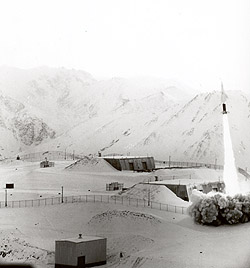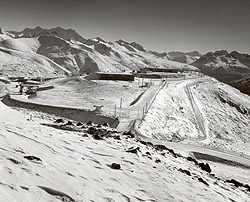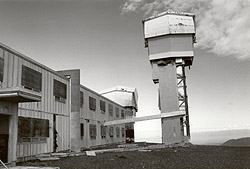
Site Summit, near Anchorage, Alaska, is an exceptionally well preserved Cold war-era Nike-Hercules missile installation and an important physical representation of U.S. military strategy during the Cold War. During World War II the U.S. Army recognized that advancements in Germany's aircraft and missile technology had made America's existing conventional artillery obsolete. In response, Army ordnance studies focused on developing a surface-to-air guided missile system that could intercept and destroy attacking airplanes. The Nike and Nike-Hercules missile systems were essential components of the United States' military defense system during the Cold War period. Established in response to the increasing threat of long range Soviet bombers carrying nuclear and conventional weapons, the Nike program provided an important surface-to-air missile system capable of destroying incoming enemy aircraft. More than 250 Nike-Hercules missile batteries were built across the United States during the late 1950s and early 1960s, protecting strategic military and civilian targets.

A total of eight Nike batteries were erected in Alaska. Because of its proximity to the Soviet mainland, Alaska was considered a pivotal location in the United States' first line of defense from anticipated Soviet aggression. Alaska's eight Nike installations were critical to the overall military strategy for the air defense of the country, representing crucial components in the military network of detection, identification, interception, and destruction. Site Summit, located atop Mount Gordo Lyon just outside Anchorage, was situated to protect Fort Richardson Army and Elmendorf Air Force bases as well as the city of Anchorage. Construction of Site Summit necessitated the blasting of approximately 60 feet of mountain peak to provide a level area for the Battery Control Building. A second ridge was leveled for the launch area. In addition to the massive rockwork, it was necessary to construct one and a half miles of road that rose 2,000 feet. Construction, supervised by the Alaska District of the U.S. Army Corps of Engineers, began in May 1957 and was completed in September 1958. The equipment arrived in February 1959 and in May the missile battery was declared operational. Washington, D.C. architect Leon Chatelain, Jr. in cooperation with Spector and Montgomery Architects, designed the original Nike facilities

On November 20, 1960, General J.H. "Iron Mike" Michaelis, Commander of the U.S. Army Alaska, told spectators gathered at the first live Nike missile test firing from Site Summit that "live-fire exercises were invaluable training in firing from actual combat sites and at the same time demonstrated to the citizens of Alaska and the Nation the power of this modern weapon." Annual firings from Site Summit continued during the months of November and December for four years until 1963. In July 1964, the Army canceled practice firings from Site Summit because population growth in the flight range area made the firings unsafe.
Typically, 125 soldiers were needed to operate a Nike site. Although not all personnel were required to live on the premises, the site was staffed 24 hours a day, seven days a week. The changing political climate and rapidly developing defense technologies, especially with the development of the intercontinental missiles, made the Nike missile bases obsolete. Nationwide, Nike batteries started phasing out in 1965. The U.S. Army intended to replace the Nike system with the SAM-D, later named the Patriot, a superior antiballistic missile system in the 1970s. "With the exception of batteries in Alaska and Florida that stayed active until the late 1970s, by 1975 all Nike-Hercules sites had been deactivated." [p 177, To Defend & Deter, The Legacy of the U.S. Cold War Missile Program, A study sponsored by the Department of Defense, Legacy Resource Management Program, Cold War Project] In May 1979, Site Summit was placed on stand down status and deactivated two months later. The Army continued to guard the site until 1986.
Site Summit is located atop Mount Gordo Lyon 12.5 miles east of downtown Anchorage. It is not accessible to the public.
Visit the National Park Service Travel American Aviation to learn more about Aviation related Historic Sites.
Last updated: October 23, 2021
